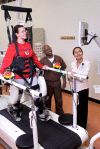Rehabilitation--emerging technologies, innovative therapies, and future objectives
- PMID: 21706265
- PMCID: PMC3148149
- DOI: 10.1007/s13311-011-0057-x
Rehabilitation--emerging technologies, innovative therapies, and future objectives
Abstract
Stroke is the leading cause of long-term disability. The goal of stroke rehabilitation is to improve recovery in the years after a stroke and to decrease long-term disability. This article, titled "Rehabilitation--Emerging Technologies, Innovative Therapies, and Future Objectives" gives evidence-based information on the type of rehabilitation approaches that are effective to improve functional mobility and to address cognitive impairments. We review the importance of taking a translational approach to neurorehabilitation, considering the interaction of motor and cognitive systems, skilled learned purposeful limb movement, and spatial navigation ability. Known biologic mechanisms of neurorecovery are targeted in relation to technology implemented by members of the multidisciplinary team. Results from proof-of-concept, within subjects, and randomized controlled trials are presented, and the implications for optimal stroke rehabilitation strategies are discussed. Developing clinical practices are highlighted and future research directions are proposed with goals to provide insight on what the next steps are for this burgeoning discipline.
Figures


Similar articles
-
Non-pharmacological interventions for spatial neglect or inattention following stroke and other non-progressive brain injury.Cochrane Database Syst Rev. 2021 Jul 1;7(7):CD003586. doi: 10.1002/14651858.CD003586.pub4. Cochrane Database Syst Rev. 2021. PMID: 34196963 Free PMC article.
-
Treatment innovation in behavioral rehabilitation of stroke: Removing limits on recovery.J Rehabil Res Dev. 2006 May-Jun;43(3):vii-x. doi: 10.1682/jrrd.2006.08.0086. J Rehabil Res Dev. 2006. PMID: 17041815 No abstract available.
-
Spatial neglect: is rehabilitation effective?Stroke. 2002 Nov;33(11):2728-9. doi: 10.1161/01.str.0000035747.03607.1a. Stroke. 2002. PMID: 12411669 Review. No abstract available.
-
Cognitive assessment and neurological rehabilitation.Clin Rehabil. 2002 Aug;16(5):575-6. doi: 10.1191/0269215502cr541xx. Clin Rehabil. 2002. PMID: 12194628 No abstract available.
-
Interventions for people with perceptual disorders after stroke: the PIONEER scoping review, Cochrane systematic review and priority setting project.Health Technol Assess. 2024 Oct;28(69):1-141. doi: 10.3310/WGJT3471. Health Technol Assess. 2024. PMID: 39485540 Free PMC article.
Cited by
-
The Application of Technological Intervention for Stroke Rehabilitation in Southeast Asia: A Scoping Review With Stakeholders' Consultation.Front Public Health. 2022 Feb 7;9:783565. doi: 10.3389/fpubh.2021.783565. eCollection 2021. Front Public Health. 2022. PMID: 35198531 Free PMC article.
-
Spatial cognitive rehabilitation and motor recovery after stroke.Curr Opin Neurol. 2014 Dec;27(6):653-8. doi: 10.1097/WCO.0000000000000148. Curr Opin Neurol. 2014. PMID: 25364954 Free PMC article. Review.
-
Neurorehabilitation: Five new things.Neurol Clin Pract. 2013 Dec;3(6):484-492. doi: 10.1212/01.CPJ.0000437088.98407.fa. Neurol Clin Pract. 2013. PMID: 24353922 Free PMC article.
-
Rehabilitation with poststroke motor recovery: a review with a focus on neural plasticity.Stroke Res Treat. 2013;2013:128641. doi: 10.1155/2013/128641. Epub 2013 Apr 30. Stroke Res Treat. 2013. PMID: 23738231 Free PMC article.
-
Predictors of Gains During Inpatient Rehabilitation in Patients with Stroke- A Review.Crit Rev Phys Rehabil Med. 2013;25(3-4):203-221. doi: 10.1615/CritRevPhysRehabilMed.2013008120. Crit Rev Phys Rehabil Med. 2013. PMID: 25541570 Free PMC article.
References
-
- DeLisa JA, Currie DM, Martin GM. Rehabilitation medicine: past, present and future. In: Rehabilitation Medicine: Principles and Practice. DeLisa JA, Gans BM, 1988:3–32.
-
- Barrett AM, Rothi LJG. Treatment innovation in behavioral rehabilitation of stroke: removing limits on recovery. J Rehabil Res Dev 2006;43:vii-x.6. Barrett AM, Levy CE, Rothi LJG. Treatment innovation in rehabilitation of cognitive motor deficits after stroke and brain injury: psychological adjunctive treatments. Am J Phys Med Rehabil. 2007;86:423–425. doi: 10.1097/PHM.0b013e31805ba039. - DOI - PMC - PubMed
Publication types
MeSH terms
Grants and funding
LinkOut - more resources
Full Text Sources
Medical

